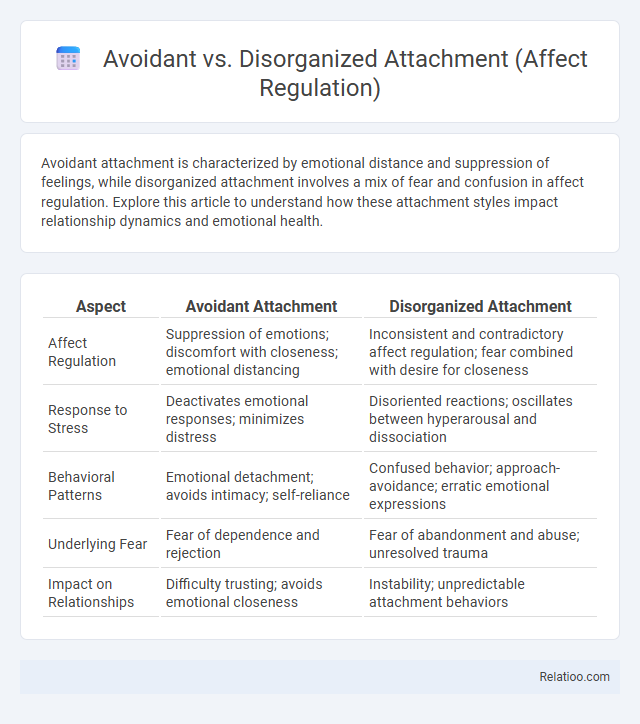Avoidant attachment is characterized by emotional distance and suppression of feelings, while disorganized attachment involves a mix of fear and confusion in affect regulation. Explore this article to understand how these attachment styles impact relationship dynamics and emotional health.
Table of Comparison
| Aspect | Avoidant Attachment | Disorganized Attachment |
|---|---|---|
| Affect Regulation | Suppression of emotions; discomfort with closeness; emotional distancing | Inconsistent and contradictory affect regulation; fear combined with desire for closeness |
| Response to Stress | Deactivates emotional responses; minimizes distress | Disoriented reactions; oscillates between hyperarousal and dissociation |
| Behavioral Patterns | Emotional detachment; avoids intimacy; self-reliance | Confused behavior; approach-avoidance; erratic emotional expressions |
| Underlying Fear | Fear of dependence and rejection | Fear of abandonment and abuse; unresolved trauma |
| Impact on Relationships | Difficulty trusting; avoids emotional closeness | Instability; unpredictable attachment behaviors |
Understanding Attachment Styles: Avoidant vs Disorganized
Avoidant attachment is characterized by emotional distance and suppression of feelings to maintain independence, while disorganized attachment involves inconsistent and confused responses to emotional needs, often stemming from trauma or neglect. Affect regulation in avoidant attachment relies on detachment and minimizing emotional expression, whereas disorganized attachment manifests in chaotic affect regulation with alternating approach and avoidance behaviors. Understanding these styles is crucial for recognizing how early relational experiences influence emotional self-regulation and interpersonal dynamics in adulthood.
Key Characteristics of Avoidant Attachment
Avoidant attachment is characterized by emotional distance, suppression of feelings, and discomfort with closeness, often leading individuals to minimize expressions of need or vulnerability. This style contrasts with disorganized attachment, which involves fluctuating affect regulation marked by fear and confusion about emotional connections. Understanding your avoidant tendencies can help improve affect regulation by promoting awareness of underlying fears and encouraging healthier emotional expression.
Defining Features of Disorganized Attachment
Disorganized attachment is characterized by contradictory behaviors, such as approaching a caregiver while simultaneously showing fear or avoidance, reflecting a breakdown in affect regulation mechanisms. This attachment style often results from trauma or inconsistent caregiving, leading to difficulty managing emotions and a lack of coherent strategies for seeking comfort. Your ability to regulate affect is compromised in disorganized attachment, causing confusion and heightened stress responses in close relationships.
Origins and Causes of Attachment Differences
Avoidant attachment typically originates from caregivers who are emotionally unavailable or consistently rejecting, leading children to suppress their expressions of distress and develop self-reliance. Disorganized attachment arises from caregivers who exhibit frightening, chaotic, or abusive behaviors, causing children to experience conflicting approach-avoidance motivations toward attachment figures. These distinct origins shape affect regulation strategies, where avoidant individuals minimize emotional expression while disorganized individuals struggle with fear and confusion in managing their emotions.
Affect Regulation in Avoidant Attachment
Avoidant attachment is characterized by a defensive affect regulation style where individuals suppress emotional expression to minimize vulnerability and maintain autonomy. Your ability to manage stress is often marked by distancing strategies that reduce emotional intensity but may hinder authentic connection. This contrasts with disorganized attachment, where affect regulation is inconsistent and fragmented, leading to confusion and heightened emotional distress.
Affect Regulation in Disorganized Attachment
Disorganized attachment is characterized by contradictory behaviors reflecting a breakdown in affect regulation, often stemming from early trauma or inconsistent caregiving. Individuals with disorganized attachment exhibit dysregulated emotional responses, alternating between hyperactivation and shutdown as coping mechanisms. Effective affect regulation in this context involves developing strategies to integrate and modulate intense emotions to foster psychological stability and secure interpersonal connections.
Behavioral Manifestations in Relationships
Avoidant attachment is characterized by emotional distancing and reluctance to rely on others, resulting in behaviors such as withdrawal and suppressed affect in relationships. Disorganized attachment often presents with inconsistent and unpredictable responses, manifesting as fear-based behaviors, confusion, and difficulty regulating emotions during interpersonal interactions. Affect regulation deficits in these attachment styles lead to challenges in expressing vulnerability, managing stress, and maintaining secure emotional connections with partners.
Impact on Emotional Health and Well-being
Avoidant attachment often leads to emotional suppression, resulting in difficulties forming close relationships and chronic stress, whereas disorganized attachment is characterized by inconsistent affect regulation, causing heightened anxiety and emotional instability. Both attachment styles negatively impact emotional health by undermining effective coping mechanisms and increasing vulnerability to mood disorders. Addressing these affect regulation challenges through therapy enhances emotional resilience and overall well-being.
Healing and Therapeutic Approaches
Avoidant and disorganized attachment styles present unique challenges in affect regulation, with avoidant individuals often suppressing emotions while disorganized attachment leads to fluctuating and unpredictable responses. Healing these attachment wounds involves therapies like Emotionally Focused Therapy (EFT) and Trauma-Focused Cognitive Behavioral Therapy (TF-CBT), which enhance emotional awareness and foster secure relational patterns. Your path to recovery benefits from consistent therapeutic interventions that build emotional resilience and promote healthy affect regulation skills.
Choosing Healthier Attachment Patterns
Choosing healthier attachment patterns involves understanding the differences between Avoidant and Disorganized Attachment, both of which impact your ability to regulate emotions effectively. Avoidant Attachment is characterized by emotional distancing and suppression of affect, while Disorganized Attachment often leads to chaotic, unpredictable emotional responses due to unresolved trauma. Developing awareness of these patterns supports better affect regulation, enabling you to build secure relationships and foster emotional resilience.

Infographic: Avoidant vs Disorganized Attachment (Affect Regulation)
 relatioo.com
relatioo.com